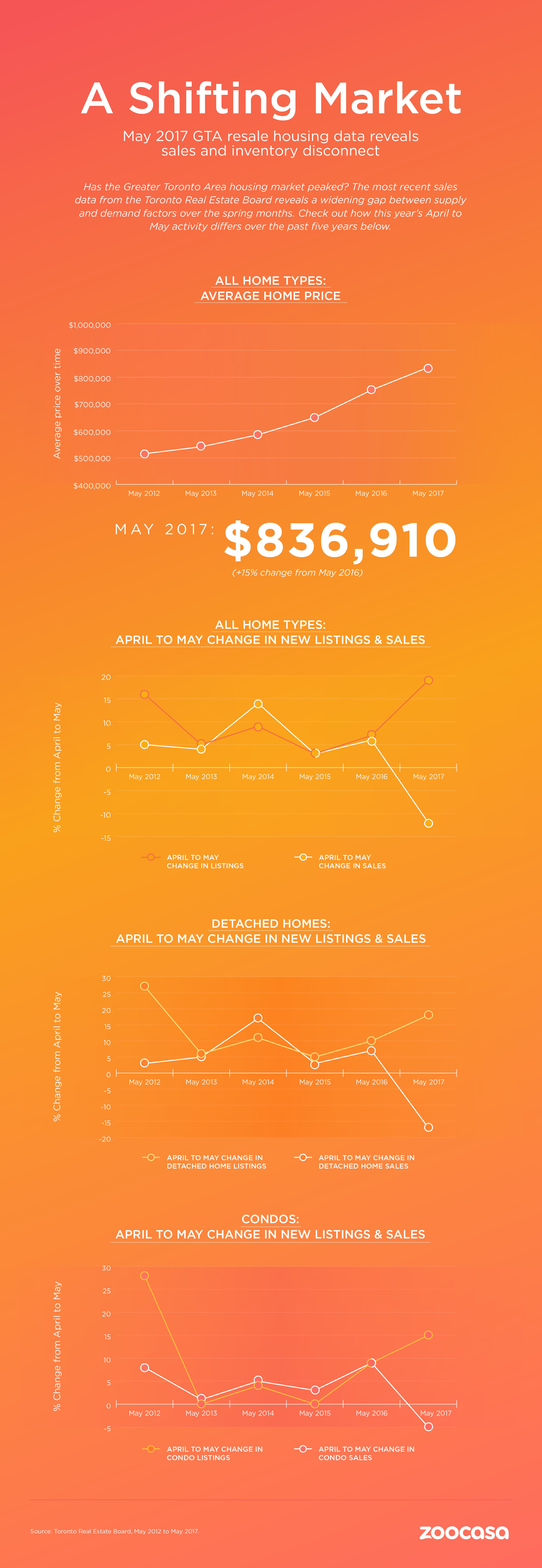By Gordon Powers, Zoocasa.com
Special to the Financial Independence Hub
Canadians’ confidence in the housing market hit an all-time high less than a month ago, but the mood across the country seems to have shifted significantly in recent weeks.
Home sales across Canada fell by 6.2 per cent in May 2017, largely due to a sharp drop in Toronto, according to the most recent figures from the Canadian Real Estate Association. The month-over-month percentage decline was the largest since August 2012.
In nearly two-thirds of all local markets across Canada, sales were off. The decline was led by a 6.7 per cent drop in the GTA, where potential home buyers seem to be moving to the sidelines, delaying their purchase decisions in the hope of a drop in runaway home prices.
Prices beginning to shift slightly
The national average price for homes sold in May was $530,304, up 4.3 per cent from where it stood a year ago. While that number has been pulled sharply upward by transactions in the GTA and Vancouver – excluding these two markets trims more than $130,000 from the national average price of $398,546 – there’s no question that prices have dropped off in certain areas of the country
Prices in the GTA declined in May for the first time in years, according to recent figures from the Toronto Real Estate Board.
While home prices in and about Toronto rose 14.9 per cent year over year, they were actually 6.2 per cent cheaper between April and May, the first full month-long period following the implementation of the Ontario Fair Housing Plan rules.
The TREB May resale numbers reveal GTA sales dropped 20.3 per cent year over year with detached home sales leading the slide at 26.3 per cent, Toronto condo sales backing off 6.4 per cent, and Toronto townhouse sales declining at 18.1 per cent.
New listings in May remained high in and around the GTA, however. The York region posted the largest month-over-month decline in new supply and similar percentage drops were also evident for new listings in Oakville-Milton and Barrie.
Ontario government’s housing plan creates impact
“This is the first full month of results since changes to Ontario housing policy made in late April. They provide clear evidence that the changes have resulted in more balanced housing markets throughout the Greater Golden Horseshoe region,” Gregory Klump, CREA’s chief economist explains. “For housing markets in the region, May sales activity was down most in the GTA and Oakville. This suggests the changes have squelched speculative home purchases.”
Market experts say the full effects of these rule changes have yet to be felt, but few expect a significant pullback in the GTA – despite headwinds such as rising interest rates, new regulations making mortgages harder to get, and the near-collapse of Home Capital Group, which provides mortgages to buyers turned away by the major banks.
Interest rates now on the rise
Higher mortgage rates are on the horizon now that Bank of Canada Governor Stephen Poloz has decided that two years of ultra-low interest rates have done their job.
Most economists are predicting that the central bank will raise its overnight lending rate by a quarter percentage point to 0.75 per cent at its July rate-setting meeting. BMO, for instance, also expects the central bank to announce a second 25-basis point hike in January, suggesting that rates could rise by another 50 to 75 basis points in 2018.
Despite this, most observers feel the Toronto market is more likely taking a breather, suggesting that those buyers who were frantically bidding a few months ago will return when they see the market stabilizing.
Evidence of a more balanced market
With sales down considerably in May, the national sales-to-new listings ratio moved out of sellers’ territory and back into a balanced situation for the first time since late 2015. The ratio stood at 56.3 per cent in May, down from 60.2 per cent in April and the high-60 per cent range over the first three months of this year.
A sales-to-new listings ratio between 40 and 60 is generally consistent with balanced housing market conditions, with readings below and above this range indicating buyers’ and sellers’ markets respectively.
Currently, the ratio still stands at above 70 per cent for Vancouver. By contrast, the ratio softened sharply in the GTA, closing out the month at 41 per cent.
The number of months of inventory is another important measure of equilibrium between housing supply and demand, indicating how long it would take to completely liquidate existing inventories at the current rate of sales activity.
There were 4.7 months of inventory on a national basis at the end of May, up from 4.3 months in April and 4.1 months in March. This returns the measure to where it was for much of 2016, Zoocasa CEO Lauren Haw notes.
With a more balanced market, agents now have to manage the expectations of both parties, she says, adding that the summer’s activity should send a clearer signal about whether this recent pullback is likely to be short-lived or the first sign of a more prolonged market adjustment.
“Sellers who need to do so urgently are anxious – they’re concerned they missed the window. However, prices have still gone up,” she says. Buyers, on the other hand, are increasing their “move-in ready” expectations, and maybe be less prepared to purchase a home needing renovations. “Buyers are less likely to overlook things they would later fix post-sale,” she says. “The seller needs to focus on greater preparation of the home, and great marketing, to net a great sale result.”
A long-time fund company executive, Gordon Powers now heads up the Affinity Group, a consulting firm focusing on retirement readiness. He is also a columnist for Investment Executive, Canada’s national newspaper for financial advisors.



